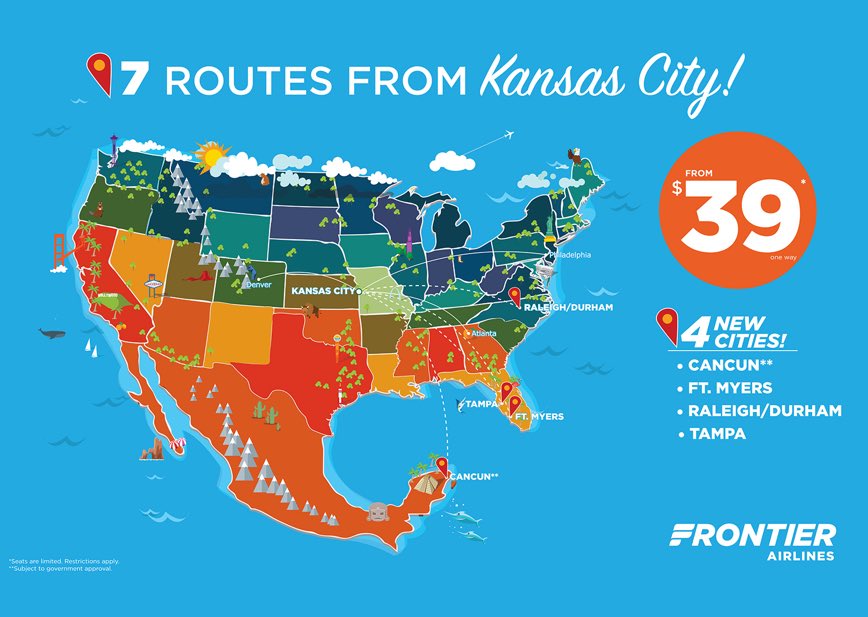Architectural renderings by design (no pun intended) are meant to evoke Ooooh’s and Ahhhhh’s. The preliminary renderings of a proposed new terminal at Kansas City International Airport, released by Edgemoor Infrastructure a few weeks ago, are no exception. And while there was much commentary about the 2-story water feature and the kids’ play area and a brief exchange about similarities to the Burns and McDonnell design, no one seemed to notice that a basic need was missing.
The renderings show no seats for passengers waiting to board their flights.
One of the most compelling justifications, if not THE most compelling, for a new terminal at KCI are crowded gate areas due to larger planes flying with increased load factors (a higher percentage of filled seats). We’re told that there is no way to enlarge the current gate areas to accommodate the increase in passengers and that the best option is a more open single-terminal. Ok, then show me how this plan solves this problem. Don’t show me a wide open gate area that looks more like a hotel lobby with a handful of people relaxing, doing business, watching kids play, etc.
Since half of KCI’s traffic flies Southwest, let’s use them as our model. They recently phased out the last of their smaller 737-300 series, and are bringing their larger 737-MAX fleet online. So if the three gates shown in the picture above are Southwest gates, they need to handle 500+ passengers simultaneously between them. When these renderings were first released on October 5th, I mentioned in a tweet to @KCIEdgemoor that I would like to see a revised rendering showing what this gate area looks like with 500+ passengers waiting for their flights. No response.
Continuing with our Southwest gate scenario, they currently use 9 gates at KCI. They have requested the same 9 in a new terminal. (Side note: By comparison, they have 14 in St. Louis. So while they could modestly increase KCI flight count with better gate efficiencies, they are not currently planning some massive shift in service at KCI with a new terminal.) More important for this conversation though is where these gates will be.
Given Southwest’s strong brand and unique boarding process, their gates need to be together. The only blocks of 9 or more gates are on the far side of the proposed terminal. But of greater concern than the fact that Southwest passengers will have the longest distance to their gates, is the question of what those 9 gate areas look like between 5:30 and 7:30 in the morning; that time we’re told, when the current KCI looks like a can of sardines. So let’s see what the 9-gate area looks like with 1,500 or so passengers waiting, arriving and changing planes.
There is a real possibility that Southwest’s gates might wrap around one of the terminal ends like they do in Dallas. The last time I was at the new Dallas Love Field I was climbing over people sitting on the floor to get to my gate. I don’t think anyone wants to see a tweet from a #NewKCI in 2021 saying, “I thought we were going to have more room.”
The KCI proposal from Edgemoor might very well solve this problem and be everything and more that single-terminal proponents have suggested from the beginning. But this is the Show-Me State. Let’s see an accurate and realistic rendering before we vote.














I just attended a town hall meeting led by councilman Fowler where it was announced that the current plans call for “floating” gates across the entire terminal. That is, each gate becomes a common shared resource that can and will serve any airline. Gate computers will be pluggable, and I presume that branding will be dynamic on displays. I am not sure how that will work out for SWA’s “boarding position pillars”.
When you look at the concept of shared common resources at domestic airports, you will find that it is a good idea for the airport operator, but airlines hate it. For one, the required shared equipment is unique to each airport, so airlines end up having to support a large variety of operational equipment. Secondly, it puts much of the control over airport operations into the hands of the common operator, making it much harder for airlines to project and control cost.
So, if this new design is supposed to cater better to airlines in order to make Kansas City a more attractive location from which to operate a larger flight volume, why introduce a concept that is detrimental to that very cause?
The IT network in the proposed new terminal will be common (connected) to all gates and ticket counters. That said, the airport recognizes the airlines prefer to have their own equipment (kiosks, computers, boarding pillars, etc). This works out in that the airlines have preferential gates/counters that they use every day (above a set level of departures) where they install their own equipment. That leaves the gates that are not used above that set level of departures to have common use equipment and be shared by airlines in situations like charters, weather delays, medical diversions, etc. When we place kiosks in spaces unleased by airlines (such as in the bridge from the parking garage) those kiosks would be non-branded / common use and will be plugged into that same IT network, providing passengers the ability to print boarding passes from all airlines at MCI.
This is extremely popular in Europe and has been for years. I guess it works ok for them but can see both sides.
It is popular in Europe where much of the traffic is international, and some airlines at some airports may only have one or two daily departures. In that scenarios, dedicated gate space would completely under-utilize the existing resources.
Justin’s explanation of the proposal details makes a lot of sense. Having a few floater gates in addition to preferential gates would indeed serve everyone much better.
One thing is for certain, this rendering shows far more space in the gate holding area than the current layout.
While I agree, we need ample seating, this is the first of many renderings I suspect. A quick review of SOM’s website (architect) shows a wide array of award-winning airport projects. Despite their first draft I have complete confidence they will deliver something most of us can be proud of.
no it does not
I would like to see some organized opposition working, before the election, to try to persuade voters to vote against ANY new terminal. It’s not broken, and it doesn’t need to be fixed. I would volunteer to help with yard signs, etc.
I will join you. KCI is not broken. Remodeling would not cost much. Some enhancements have already been done.
You are correct, it wouldn’t be as expensive but it would be a band-aid until the next go-round. Then in 10 years we would be looking at spending even more on a new terminal or another expensive renovation
We don’t need to remodel now AT ALL. The airport is functioning every day, no band=aid necessary. And we won’t need a new terminal in 10 years either (unless you listen to the promoters who are pushing for a new terminal).
Ok Bob, this contradicts what the airlines have stated as well as other stakeholders. I suppose we could leave it as-is and continue to watch it deteriorate.
The Kansas City Star and the KC Business Journal have beat writers whose sole job is to notice this kind of stuff and report on it.
That’s why I appreciate this blog. An ordinary guy with an interest in the airport, asks questions that our media and city leaders don’t ask.
The Star editorial board, in particular, is always anxious to spend other people’s money without looking at how effectively it’s being utilized.
Thanks. I appreciate that as well as your participation in the conversation.
YES!! Every new architectural design nowadays is very eye appealing but has NO place for actual people to sit.
The first rendering of the Sprint Center looks nothing like what exists today. I suspect the same will happen with the airport. It will go through many iterations based on resident and stakeholder input.